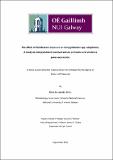| dc.contributor.advisor | Carroll, Cyril | |
| dc.contributor.author | Barczynska, Alicja | |
| dc.date.accessioned | 2014-01-23T15:20:45Z | |
| dc.date.available | 2014-01-23T15:20:45Z | |
| dc.date.issued | 2014-01-21 | |
| dc.identifier.uri | http://hdl.handle.net/10379/4017 | |
| dc.description.abstract | Campylobacter spp. are a common source of food contamination, especially in poultry products. To reduce the level of campylobacteriosis occurrence, different intervention strategies at poultry farms and processing plants (among them the application of disinfectants) have been proposed. The use of disinfectants can only be officially approved following a risk assessment. This study set out to investigate a possible adaptation of campylobacters to disinfectants recognised as safe for poultry decontamination: lactic acid (LA), citric acid (CA), acidified sodium chlorite (ASCh) and trisodium phosphate (TSPh).
From an initial pool of seventeen campylobacters, six of them were chosen for adaptation studies to disinfectants, after genotypic and phenotypic screening. C. jejuni, following continuous culture in the presence of gradual incremental concentrations of disinfectant, showed an ability to grow up to 8-fold above the initial MIC value when ASCh was examined and up to 2-fold when LA and CA were examined. Chemostat derived strains adapted to CA and ASCh were less susceptible to supra-MIC concentrations upon repeated exposure to the disinfectants, while a chemostat derived strain adapted to LA showed increased susceptibility to LA at supra-MIC concentration. In the case of TSPh, although Campylobacter failed to grow at the MIC value in the chemostat culture, strains obtained were less susceptible to TSPh than their WT.
TSPh and CA challenged strains revealed overexpression of all virulence genes studied (ciaB, cmeA, cdtB, flgS) while ASCh challenged strains revealed overexpression of ciaB only. In the case of strains challenged with LA no significant changes in gene expression were observed. The study on proteome changes showed that a majority of the proteins were down-regulated with an increase in the disinfectant concentrations. The changes in protein expression indicated an oxidative stress defence response indicating an overlap between the acid and oxidative stress response mechanisms. | en_US |
| dc.rights | Attribution-NonCommercial-NoDerivs 3.0 Ireland | |
| dc.rights.uri | https://creativecommons.org/licenses/by-nc-nd/3.0/ie/ | |
| dc.subject | Campylobacter | en_US |
| dc.subject | Chemostat | en_US |
| dc.subject | Adaptation to disinfectants | en_US |
| dc.subject | Virulence gene expression | en_US |
| dc.subject | Protein expression | en_US |
| dc.subject | Microbiology | en_US |
| dc.title | The effect of disinfectant exposure on Campylobacter spp. adaptation; A study on Campylobacter survival and on proteome and virulence genes expression | en_US |
| dc.type | Thesis | en_US |
| dc.contributor.funder | This project was funded under the Irish National Development Plan, through the Food Institutional Research Measure administrated by the Department of Agriculture Fisheries and Food. | en_US |
| dc.local.note | Campylobacter is a worldwide food-borne pathogen associated with poultry products. In order to decrease the incidence of disease, different disinfectants for cleaning poultry farms and processing plants have been considered. However, unsuitable disinfectants could produce stronger and more pathogenic bacteria, and they must be tested before their application. | en_US |
| dc.local.final | Yes | en_US |
| nui.item.downloads | 1330 | |


